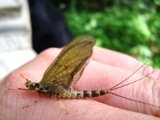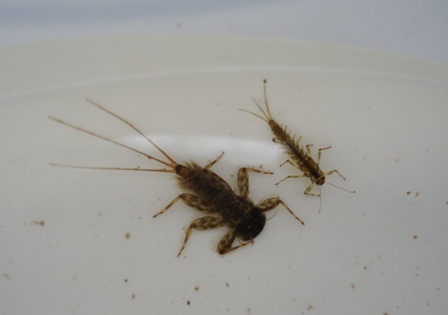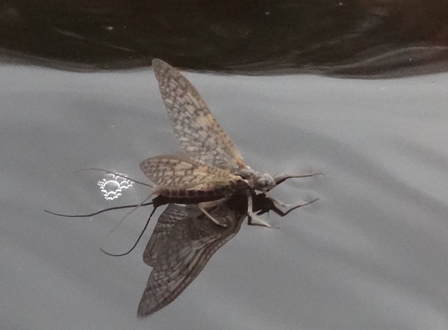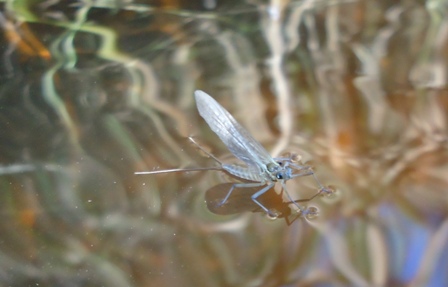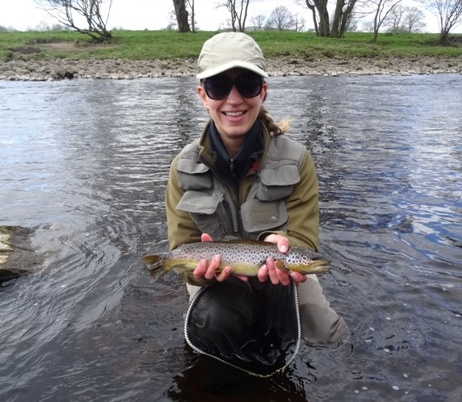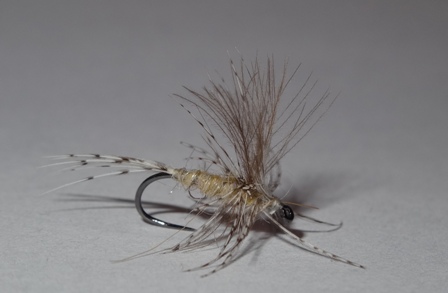| Back to Back Issues Page |
 |
|
May and June on the River May 26, 2015 |
May and June on the RiverLate Spring and early Summer is a time of great opportunity to the River fly fisher. For the trout and grayling it is time to make hay while the sun shines or to pack on weight and condition whilst the going is good and food is becoming available. As the summer progresses and terrestrial insects become abundant the trout’s diet becomes diverse but in May and June the aquatic species of insect make up the bulk of the diet and in particular the iconic Mayfly. Here I use the term mayfly to represent the whole order of insects with upright wings.
The “classical” mayfly Ephemera danica In fact the larval forms or nymphs of Mayfly vary in form. As nymphs the insect spends almost all its life inside the river near or in the river bed (often on the underside of rocks or stones). The image below shows 2 mayfly nymphs. The adult of the fat nymph on the left represents something like the March brown dun. The skinny nymph will become something like the pale watery dun shown
Two species of Mayfly Nymph
March Brown Dun
Pale Watery Dun In fact Mayfly will be the dominant species on most trout rivers during May and into June. And as fly fishers this is very important to us. Fly patterns that represent either the nymph forms or dun forms (freshly emerged) of these insects will bring us optimum success. Softly does it! In terms of subsurface or nymph patterns there are two Onstream-guide patterns that broadly copy the features of this type of nymph. The hotspot pheasant tail nymph with a soft CdC hackle and the mini and micro hares ear nymph. These are great fished on a nymph rig (under an indicator) fished upstream before a hatch occurs, or as a duo suspended under a dry fly. There are also flies that copy the process of emergence including the plover spider and plover nymph with their soft hackles. These imitate the nymphs struggling to reach the river surface and emerge as a dun. An amazing metamorphosis which takes land based insects like houseflies weeks to complete. The transformation of the larval form (a maggot in this case), to an adult (winged true fly), via a chrysalis (a castor). In our aquatic fly or mayfly this process takes an instant and the adult burst out from a larval skin (shuck) as a dun in less than a second.
Nellie with a big wild trout caught on our mayfly nymph pattern. However it is fishing the dun or pre-adult form as a dry fly that brings us most joy! Match the hatch Pale watery and the fantastic soft hackle dry patterns are particularly effective. This season we have been fishing these patterns and having great success both as targeted patterns cast for visibly rising fish and to bring fish up blind. The soft hackle has been particularly effective at bringing fish up to take it in bubbly water near the heads of pools. Even if any hatch of Mayfly is sparse. These are our fly recommendations for the coming weeks. Soft hackled flies offer a great advantage as nymphs spiders or adults by maximising movement.
The soft hackle dry fly imitates a wide range of Mayfly that hatch in May and June on Many Rivers. Fishing upstream dry fly is a beautiful way to catch trout on any river and May and June affords us an excellent opportunity to do just that. Remember a furled leader greatly aids dry fly fishing and personally I would never fish a river without one. Best wishes and a fruitful May and June to you all. We will produce a video showing a beautiful but simple method of fishing a dry mayfly in the coming weeks. Jonathan and Nellie. |
| Back to Back Issues Page |
